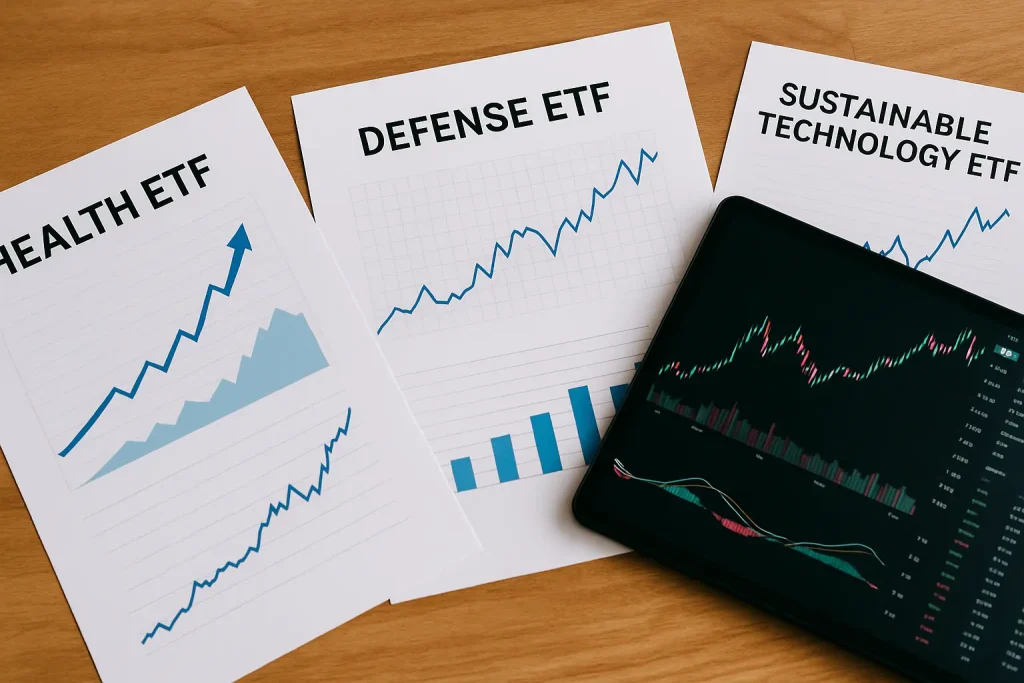In 2025, thematic ETFs in the US are among the most sought-after investment products. Unlike traditional funds that mirror broad indexes, thematic ETFs concentrate on industries or trends with high growth potential. This approach allows investors to align portfolios with innovation, structural change, and long-term market opportunities that extend beyond short-term speculation.
The rise of these funds reflects how financial markets adapt to economic and geopolitical shifts. Health, defense, and sustainable technology are now dominant areas of focus. By blending profitability with strategic relevance, thematic ETFs in the US attract investors who want exposure to growth sectors while also supporting industries that matter for the future.
Page Contents
ToggleWhy Thematic ETFs Are Gaining Popularity

The main appeal of thematic ETFs lies in their targeted nature. Instead of spreading money across hundreds of companies, they allocate resources to fewer, promising firms. This increases the chance of high returns but also raises volatility, requiring a balanced and informed approach. Investors drawn to these products must weigh risks carefully.
Accessibility adds to their momentum. Online platforms make it simple to purchase thematic ETFs, often at lower costs than traditional funds. As awareness grows, more Americans are turning to thematic ETFs in the US as a practical way to diversify while tapping into innovation. This combination of simplicity and focus explains their continued growth in 2025.
Key Sectors Driving Growth
Three sectors dominate the thematic ETF landscape in 2025, reflecting megatrends unlikely to fade soon. They represent both economic opportunity and global relevance, making them attractive for investors seeking aligned strategies. Each sector combines structural demand with the promise of long-term resilience, balancing risk with innovation.
| Sector | Focus Area | Growth Drivers |
|---|---|---|
| Health | Biotechnology and medical innovation | Aging population and personalized medicine |
| Defense | Aerospace, cybersecurity, defense contractors | Rising geopolitical tensions and security needs |
| Sustainable Tech | Renewable energy, EVs, clean tech | Global climate goals and regulatory support |
These examples show how thematic ETFs in the US are more than speculative bets. They are structured vehicles linking profit with social progress and industry transformation, giving investors opportunities to support key global challenges.
Best Ways to Invest in Thematic ETFs
Success in thematic ETFs requires strategy and discipline. Investors should research carefully, avoid overexposure, and align allocations with broader goals. While rewards can be attractive, risks demand constant evaluation. The most effective approach is balancing enthusiasm for innovation with financial responsibility, ensuring resilience over time.
- Analyze long-term trends shaping each theme.
- Compare expense ratios, liquidity, and fund structures.
- Diversify exposure across multiple high-potential sectors.
- Reassess portfolio relevance on a regular basis.
By applying these practices, investors align portfolios with innovation and opportunity. Using thematic ETFs in the US strategically ensures exposure to growth while reducing risk. This balance makes them effective tools for future-focused investment strategies that emphasize sustainability.
Key considerations for 2025
Thematic ETFs combine optimism with caution, reflecting both opportunity and risk. Market cycles, geopolitical events, and regulatory changes all influence results. Investors who adapt to these forces position themselves better for consistent returns, avoiding the pitfalls of short-term speculation. Careful monitoring remains critical in an evolving environment.
In 2025, awareness is the most valuable asset. Those who evaluate fundamentals, study sector dynamics, and diversify intelligently will capture the benefits without excessive exposure. This pragmatic approach allows thematic strategies to support both wealth creation and stability, ensuring relevance as industries evolve.
Conclusion
Thematic ETFs have shifted from niche interest to mainstream solutions. In the US, health, defense, and sustainable technology lead the way, attracting investors eager to connect portfolios with innovation. This growth reflects how thematic products unite financial opportunity with broader social and strategic goals that define future markets.
Yet, the rise of thematic ETFs in the US requires more than enthusiasm. Careful evaluation of risks and benefits ensures that these funds serve as sustainable investment tools rather than speculative gambles. For 2025, combining analysis with discipline remains the clearest path to long-term success.



